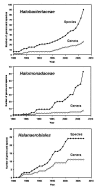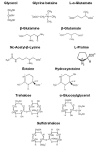Microbial life at high salt concentrations: phylogenetic and metabolic diversity
- PMID: 18412960
- PMCID: PMC2329653
- DOI: 10.1186/1746-1448-4-2
Microbial life at high salt concentrations: phylogenetic and metabolic diversity
Abstract
Halophiles are found in all three domains of life. Within the Bacteria we know halophiles within the phyla Cyanobacteria, Proteobacteria, Firmicutes, Actinobacteria, Spirochaetes, and Bacteroidetes. Within the Archaea the most salt-requiring microorganisms are found in the class Halobacteria. Halobacterium and most of its relatives require over 100-150 g/l salt for growth and structural stability. Also within the order Methanococci we encounter halophilic species. Halophiles and non-halophilic relatives are often found together in the phylogenetic tree, and many genera, families and orders have representatives with greatly different salt requirement and tolerance. A few phylogenetically coherent groups consist of halophiles only: the order Halobacteriales, family Halobacteriaceae (Euryarchaeota) and the anaerobic fermentative bacteria of the order Halanaerobiales (Firmicutes). The family Halomonadaceae (Gammaproteobacteria) almost exclusively contains halophiles. Halophilic microorganisms use two strategies to balance their cytoplasm osmotically with their medium. The first involves accumulation of molar concentrations of KCl. This strategy requires adaptation of the intracellular enzymatic machinery, as proteins should maintain their proper conformation and activity at near-saturating salt concentrations. The proteome of such organisms is highly acidic, and most proteins denature when suspended in low salt. Such microorganisms generally cannot survive in low salt media. The second strategy is to exclude salt from the cytoplasm and to synthesize and/or accumulate organic 'compatible' solutes that do not interfere with enzymatic activity. Few adaptations of the cells' proteome are needed, and organisms using the 'organic-solutes-in strategy' often adapt to a surprisingly broad salt concentration range. Most halophilic Bacteria, but also the halophilic methanogenic Archaea use such organic solutes. A variety of such solutes are known, including glycine betaine, ectoine and other amino acid derivatives, sugars and sugar alcohols. The 'high-salt-in strategy' is not limited to the Halobacteriaceae. The Halanaerobiales (Firmicutes) also accumulate salt rather than organic solutes. A third, phylogenetically unrelated organism accumulates KCl: the red extremely halophilic Salinibacter (Bacteroidetes), recently isolated from saltern crystallizer brines. Analysis of its genome showed many points of resemblance with the Halobacteriaceae, probably resulting from extensive horizontal gene transfer. The case of Salinibacter shows that more unusual types of halophiles may be waiting to be discovered.
Figures





References
-
- Trüper HG, Severin J, Wolhfarth A, Müller E, Galinksi EA. In: General and Applied Aspects of Halophilism. Rodriguez-Valera F, editor. New York: Plenum Press; 1991. Halophily, taxonomy, phylogeny and nomenclature; pp. 3–7.
-
- Kushner DJ. In: Microbial Life in Extreme Environments. Kushner DJ, editor. London: Academic Press; 1978. Life in high salt and solute concentrations; pp. 317–368.
-
- Oren A. Halophilic Microorganisms and their Environments. Dordrecht: Kluwer Scientific Publishers; 2002.
-
- Oren A. In: The Prokaryotes. A Handbook on the Biology of Bacteria: Ecophysiology and Biochemistry. Dworkin M, Falkow S, Rosenberg E, Schleifer K-H, Stackebrandt E, editor. Vol. 2. New York: Springer; 2006. Life at high salt concentrations; pp. 263–282.
LinkOut - more resources
Full Text Sources

